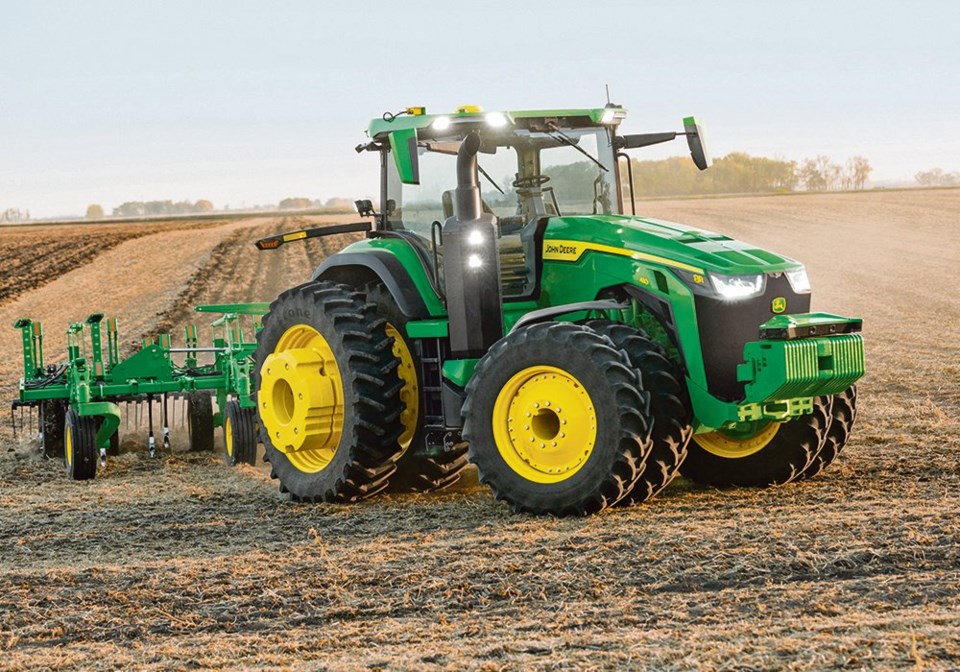WESTERN PRODUCER — Last week on a stage in Las Vegas, John Deere’s first autonomous tractor that farmers could order debuted without an acre of dirt in sight.
It wasn’t a farm show or a dealer event. It was at the Consumer Electronics Show.
Long known for more than consumer electronics, that event has evolved into a showcase of the latest technologies in computing that fall into the interface between human and machine. Farmers know their operational world has been depending on advanced electronics for a couple of decades, a trend that has increased every season. But taking those steps outside of the cab are underway now.
“People ask us why is Deere at CES? … We are a technology company, we’ve always been a technology company when you think about it,” said Jahmy Hindman, referring to the first steel plow invented by John Deere in 1837.
The chief technology officer for Deere said that farmers know how much of their daily lives rely on the latest technologies, so offering them the company’s first autonomous tractor at the Vegas show seemed appropriate.
Deere has shown off cab-free prototypes and concept tractors for more than a dozen years. Even an electric unit that got its power from very long extension cords. But those didn’t allow for a seat, making them harder to transport and likely sell to producers who have multiple uses for their large, wheeled investments.
Hindman got to unveil the new 8R, fixed-frame. And unlike many prototypes from a variety of sources, this one doesn’t appear to have a lot of extra parts bolted on. The tractor looks like an 8R, the mid-range Deere units that run between 230 and 410 horsepower, tipping the scales at about 28,000 pounds, sans ballast. It just doesn’t need a driver and that helps to meet many of the labour shortage problems producers face.
“There is an increasing gap between the labour needed and labour available,” said Hindman. “Farmers need technology to help them do more with less, to minimize their inputs and maximize output to put food on the table.”
Julian Sanchez of Deere’s emerging technology sector said the new tractor, which producers can begin ordering later this year, needs only to have the operator move it from field to field.
Initially, the new autonomous 8Rs will be handling tillage duties, he said, however airseeding isn’t much of operational jump from cultivating.
“On your phone, you swipe left to right (using the tractor’s app) and the machine signals the all-clear and starts working. The farmer can leave it now, which does require a tremendous amount of trust,” he said in Las Vegas.
Gaining that trust is built into the technology and path Deere took to get to this point. Years of collecting more than 50 million farm field images have gone into building the artificial intelligence system that, through six stereo cameras sees all around the machine, said Willy Pell of Deere’s Blue River division.
Blue River was a company that developed smart sprayer systems and was acquired by John Deere a few years ago.
Last year, Deere acquired autonomous tractor guidance company Bear Flag, however its solutions had been designed to bolt on, rather than be integrated.
Tell said the new 8R can calculate distance (with what it sees with its cameras, like a two eyes) using machine learning.” The tractor learns new obstacles and when it can’t identify something in its path, it stops.
Both AI and machine learning are at work, as the technology uses tools known as deep neural networks, akin to an electronic, decision-capable brain. The cameras feed captured images to that web, flowing caught pixels through in about 100 milliseconds. In that time, the tractor decides on its own to keep rolling or stop.
The farmer need not be field side while the tractor works, said Deanna Kovar, vice-president of Deere’s precision side.
She said the saved hours can be used to tender machines or do unrelated work on the farm, “more or better, making the farm more efficient.”
“(This tractor) can go through the field autonomously to within an inch to prepare the soil. It’s fitting this next revolution is the same job of tillage that John Deere, the man, revolutionized 185 years ago,” she said.
“Instead of working from inside a cab 18 hours a day, which is physically and mentally exhausting, with the autonomous tractor they’re getting back valuable time. That time could be spent with family too. Improving a farmer’s life,” said Kovar.
Sanchez said producers get live access to the tractor and are alerted to any situations that might need their attention through the company’s Operations Center. Farmers can see what the tractor sees as well as all the data it is collecting.
He said while the machine is operating autonomously for eight to 10 hours between fuel or field-moves, it is also collecting large amounts of field data and learning as it goes.
“It is creating a digital footprint of the farm. Every acre, every inch,” he said.
Tillage is a starting point, said Jorge Heraud, a founder of Blue River and now Deere’s vice-president of autonomy and automation.
He said planting, green on green weed identification for sprayers, the same camera systems mounted on combines monitoring the crops on-the-go and adding to the data sets for the farm’s marketing and next season’s planning are all in the near future for the company.
“It’s no longer a concept or demo. It’s here,” he said.

